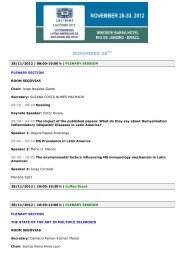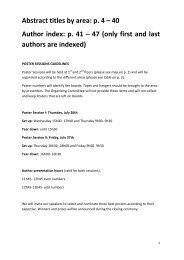Keynote Conference - Interevent
Keynote Conference - Interevent
Keynote Conference - Interevent
You also want an ePaper? Increase the reach of your titles
YUMPU automatically turns print PDFs into web optimized ePapers that Google loves.
Symp#29 MMPs and TIMPs<br />
Chairs Ruy Jaeger<br />
Membrane Type I- Matrix Metalloproteinase (MMP14): A Multifaceted Cell Surface Protease in Cancer<br />
Stanley Zucker<br />
Stony Brook University, USA<br />
MMP14, an intrinsic plasma membrane proteinase, plays a critical role in digesting basement membrane and<br />
extracellular matrices and in inducing cancer cell migration, thereby promoting cancer invasion and metastasis. We<br />
and others have demonstrated that MMP14 is highly expressed in most human cancers and correlates with poor<br />
clinical outcome. We have evaluated the role of MMP14 in converting quiescent tumor initiating cells (TICs) to<br />
metastatic cancer cells. Our studies of the hemopexin (PEX) domain of MMP14 have shown that of the 4 outermost<br />
blades, strands I and IV are essential fo cell migration. Peptides mimicking these outermost strands reduced cancer<br />
cell migration and angiogenesis in vitro and lung metastasis in vivo. We next examined the effect of cellular hypoxia on<br />
MMP14 function in TICs. SK-3rd TICs, isolated by passage of human breast cancer cells in immunodeficient mice,<br />
display enhanced lung metastases. Surprisingly, under normoxic conditions, SK-3rd cells displayed minimal increase in<br />
cancer invasion. However, when cultured under hypoxic conditions, a dramatic increase in cell invasiveness in 3D<br />
collagen gels was demonstrated, which coincided with increased localization of MMP14 at the cell surface. These data<br />
suggest that induction of TIC invasion during hypoxia is caused by enhanced trafficking of MMP14 from the trans Golgi<br />
network to the plasma membrane. MMP14 also induces the generation of reactive oxygen species in cancer cells,<br />
leading to enhanced cancer aggressiveness. Our most recent studies incriminated tumor growth factor-beta as a key<br />
intermediary in MMP14 cell signaling in cancer progression.<br />
Rama Khokha<br />
University Western Ontario, Toronto, Canada<br />
Role of matrix metalloproteinases and inflammasome pathway in the development of airway inflammation and<br />
fibrosis<br />
Vincent Lagente<br />
UMR991 INSERM/Université de Rennes 1, Faculté de Pharmacie,<br />
2 avenue du Prof Léon Bernard, 35043 Rennes cedex, France<br />
Matrix metalloproteinases (MMPs) are a major group of proteases known to regulate the turn-over of extracellular<br />
matrix and so they are suggested to be important in the process of lung disease associated with tissue remodelling.<br />
Pulmonary fibrosis has an aggressive course and is usually fatal for an average of three to six years after the onset of<br />
symptoms. Pulmonary fibrosis is associated with deposition of extracellular matrix (ECM) components mainly collagen<br />
in the lung interstitium. The excessive airway remodeling as a result of an imbalance in the equilibrium of the normal<br />
processes of synthesis and degradation of extracellular matrix components could be in favor of anti-protease<br />
treatments. We previously demonstrated a significant inhibition of bleomycin-induced pulmonary fibrosis in mice by<br />
the MMP inhibitor batimastat. We also reported a correlation of the differences in collagen deposition in the lungs of<br />
bleomycin-treated mice with a reduced molar pro-MMP-9/TIMP-1 ratio in broncholaveolar lavage fluid, beginning as<br />
early as the inflammatory events at day 1 after bleomycin administration. The differences in TIMP-1 level, particularly<br />
at early events after bleomycin administration, suggest that early altered regulation of matrix turnover may be<br />
involved in the further development of bleomycin-induced pulmonary fibrosis. We also demonstrated that<br />
Inflammasome-NLRP3 pathway associated with the IL-1R/MyD88 signaling is required in the bleomycin-induced<br />
increased TIMP-1 level and pulmonary fibrosis in mice. Finally, these observations emphasize those effective therapies<br />
for these disorders must be given early in the natural history of the disease, prior to the development of tissue<br />
remodeling and fibrosis.<br />
81





